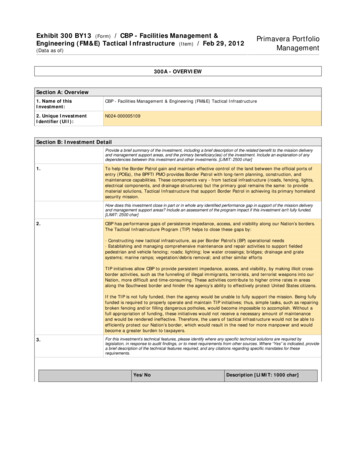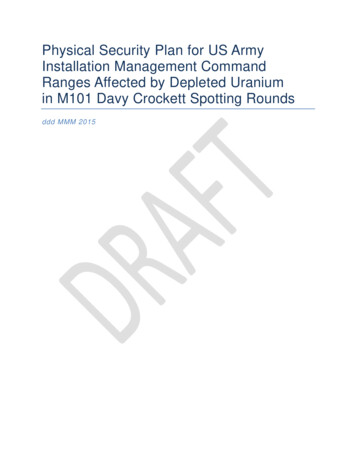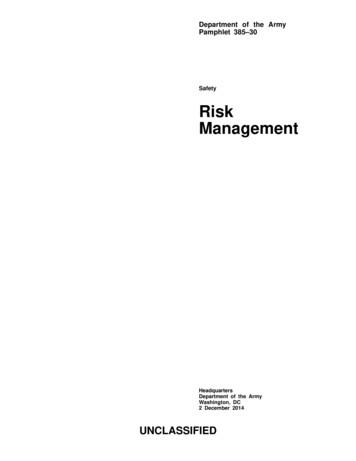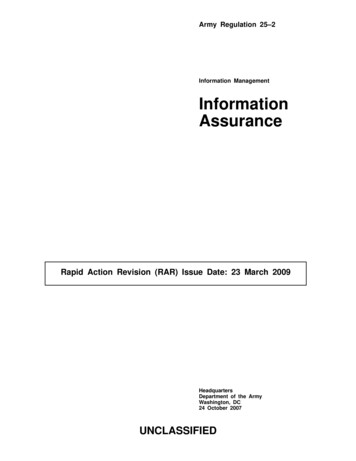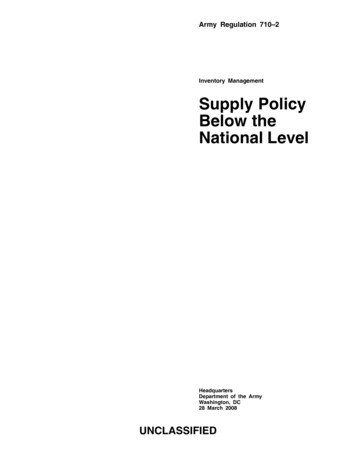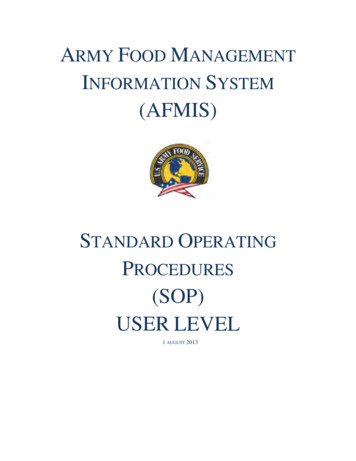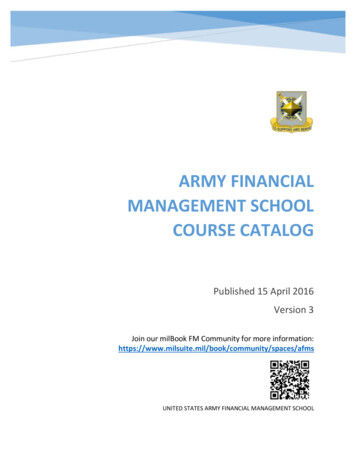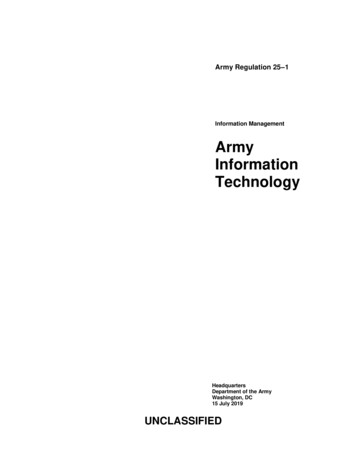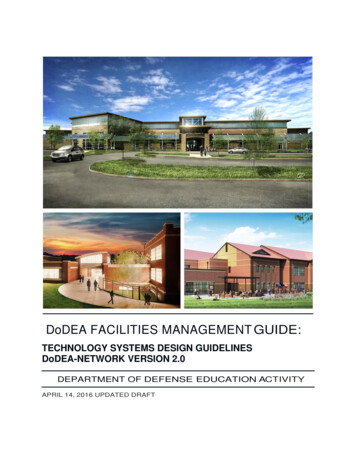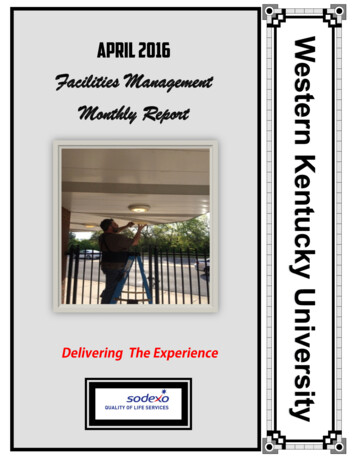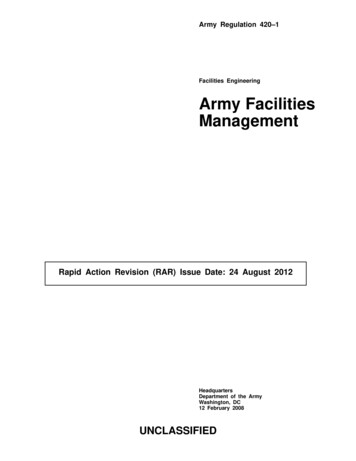
Transcription
Army Regulation 420–1Facilities EngineeringArmy FacilitiesManagementRapid Action Revision (RAR) Issue Date: 24 August 2012HeadquartersDepartment of the ArmyWashington, DC12 February 2008UNCLASSIFIED
SUMMARY of CHANGEAR 420–1Army Facilities ManagementThis administrative revision, dated 6 March 2019—o Refers users to Army Directive 2018-29 (Non-Federal Entity Competition WithAppropriated and Nonappropriated Fund Activities on Army Installations), dated17 December 2018, which provides policy affecting this regulation.This rapid action revision, dated 24 August 2012-oOnly updates chapter 3 to reflect the removal of procedural material used todevelop DA Pam 420-1-1.oOnly updates chapter 7 to reflect the removal of procedural material used todevelop DA Pam 420-1-3.oMakes administrative changes (App A: Added the following publications: AR 2710, 36 CFR 251.56, 41 CFR 102-32, DOD 5500.7-R, DODI 1015.10, DODI 1100.16,DODI 1225.9, EPA PB94-163-95-250, PL 90-284, PL 98-115, UFC 3-120-10, UFC 3250-18FA, UFC 3-260-03, UFC 3-310-05A, UFC 3-400-01, UFC 3-430-09, UFC 4-01002, UFC 4-711-01, UFC 4-721-01A, UFC 4-721-11.1, UFC 4-860-01FA, UFC 4-86003, UFGS 22 51 15, and 10 USC 2922. Corrected the following publicationtitles: AR 710-3, DA Pam 5-20, DA Pam 420-1-1, DA Pam 420-1-2, DA Pam 420-1-3,DA Pam 600-45, DA Pam 708-1, EM 385-1-1, FHWA PD-96-001, FM 7-0, NFPA 72, NFPA96, PWTB 200-1-4, PWTB 200-1-14, TI 800-01, UFC 1-900-01, UFC 3-230-08A, UFC3-550-03FA, UFC 3-560-01, UFC 3-700-01A, UFC 4-020-02FA, UFC 4-020-03FA, andUFC 4-020-04FA. Removed "-STD" from DOD 6055.09. Deleted the followingpublications: AR 95-2, AR 672-20, AR 700-138, AR 740-1, AFARS 45.6, 26 CFR251.56, EO 13148, EO 13149, EPA 530-R-95-003, ICSSC RP 2.1A, NISTIR 5382, TM5-682, TM 5-800-4, TM 5-811-1/AFJMAN 32-1080, TM 5-813-3/AFM88-10, Vol 3, TM5-853-1/AFMAN 32-1071, Vol 1, TM 5-853-2/AFMAN 32-1071, Vol 2, TM 5-853-3/AFMAN 32-1071, Vol 3, and TM 5-853-4. Removed the following obsoletepublications: DA Pam 200-1, DA Pam 415-15, DODD 1015.2, DODI 7310.1, 29 CFR1910.139, 49 CFR 1.48, TM 5-644, TM 5-646, TM 5-651, UFC 3-430-05FA, UFGS 33 5103.00 10, UFGS 33 51 06.00 20, and 10 USC 2672. Updated all publication Websites. Corrected the following form titles: DA Form 11-2 and HUD Form 903.1.Updated DA Form 373-R-E. Deleted DD Form 1970).This administrative revision, dated 17 June 2009-oImproves clarity by correcting terminology used for assessment of risks (para25-4f(8), 25-4i(5), 25-16, 25-20, 25-39a, and 25-46).oMakes administrative changes (throughout).
*Army Regulation 420–1HeadquartersDepartment of the ArmyWashington, DC12 February 2008Effective 19 February 2008Facilities EngineeringArmy Facilities Managementbeen licensed to the District of Columbiaor to any state, territory, or commonwealth of the United States for use by theNational Guard; single project-owned orleased civil works facilities of the U.S.Army Corps of Engineers; national cemeteries; facilities occupied by Army activities as tenants when support is providedby another government agency. In areasoutside the United States, Status of ForcesAgreements or other country-to-countryagreements may take precedence over thisregulation.History. This publication is anadministrative revision. The portionaffected by this administrative revision islisted in the summary of change.Summary. This regulation addresses themanagement of Army facilities. Specifically, it describes the management of public works activities, housing, and otherfacilities operations and management, military construction program developmentand execution, master planning, utilitiesservices and energy management, and fireand emergency services. Also, it identifiesand synopsizes other regulations that provide detailed facilities managementpolicy.Applicability. This regulation applies tothe Active Army, the Army NationalGuard/Army National Guard of the UnitedStates, and the U.S. Army Reserve, unlessotherwise stated. Also, it applies to tenants on active Army installations, or asnoted in each program chapter. This regulation does not apply to installations andactivities, or parts thereof, which haveProponent and exception authority.The proponent of this regulation is theAssistant Chief of Staff for InstallationManagement. The proponent has the authority to approve exceptions or waiversto this regulation that are consistent withcontrolling law and regulations. The proponent may delegate this approval authority, in writing, to a division chief withinthe proponent agency or its direct reporting unit or field operating agency, in thegrade of colonel or the civilian equivalent.Activities may request a waiver to thisregulation by providing justification thatincludes a full analysis of the expectedbenefits and must include a formal reviewby the activity’s senior legal officer. Allwaiver requests will be endorsed by thecommander or senior leader of the requesting activity and forwarded throughtheir higher headquarters to the policyproponent. Refer to AR 25–30 for specificguidance.Army management control process.This regulation contains management control provisions and identifies key management controls that must be evaluated (seeappendix T).Supplementation. Supplementation ofthis regulation and establishment of command and local forms are prohibited without prior approval from the AssistantChief of Staff for Installation Management (DAIM–ODF), 600 Army Pentagon,Washington, DC 20310–0600.Suggested improvements. Users areinvited to send comments and suggestedimprovements on DA Form 2028 (Recommended Changes to Publications andBlank Forms) directly to Headquarters,Department of the Army, Assistant Chiefof Staff for Installation Management(DAIM–ODF), 600 Army Pentagon,Washington, DC 20310–0600.Committee Continuance Approval.AR 15–1 requires the proponent to justifyestablishing/continuing committee(s), coordinate draft publications, and coordinatechanges in committee status with the U.S.Army Resources and Programs Agency,Department of the Army Committee Management Office (AARP–ZA), 9301Chapek Road, Building 1458, Fort Belvoir, VA 22060–5527. Further, if it is determined that an established “group”identified within this regulation, latertakes on the characteristics of a committee, as found in the AR 15–1, then theproponent will follow all AR 15–1 requirements for establishing and continuingthe group as a committee.Distribution. This publication is available in electronic media only and is intended for command levels C, D, and Efor the Active Army, the Army NationalGuard/Army National Guard of the UnitedStates, and the U.S. Army Reserve.*This regulation supersedes AR 420–1, dated 2 November 2007. This edition publishes a rapid action revision of AR 420–1.AR 420–1 12 February 2008/RAR 24 August 2012UNCLASSIFIEDi
Contents(Listed by paragraph and page number)Part OneGeneral Installation Management, page 1Chapter 1Introduction, page 1Purpose 1–1, page 1References 1–2, page 1Explanation of abbreviations and terms 1–3, page 1Responsibilities 1–4, page 1Installation Management Board of Directors 1–5, page 5Chapter exponents 1–6, page 5Chapter 2Management of Public Works Activities, page 6Section IIntroduction, page 6Overview 2–1, page 6Applicability 2–2, page 6Chapter exponent 2–3, page 6Chapter responsibilities 2–4, page 6Section IIGeneral Public Works Operations Policy, page 7Basic functions 2–5, page 7Work and cost reporting 2–6, page 8Work planning 2–7, page 8Customer service 2–8, page 8Alternative methods and sources 2–9, page 9Host-tenant relationship 2–10, page 9Government furnished, contractor occupied facilities 2–11, page 9Section IIIOperation and Maintenance Project Approval and Execution (see chapter 3 for Army Family Housing), page 9General 2–12, page 9World War II temporary buildings 2–13, page 10Authorization for minor construction projects 2–14, page 10Minor construction prohibitions and limitations 2–15, page 11Authorization for maintenance and repair projects 2–16, page 11Project costs 2–17, page 12Project technical review 2–18, page 13Damaged facilities 2–19, page 13Combined funded construction projects 2–20, page 13Real property facilities project files 2–21, page 13Section IVUtilization of Personnel and Administration, page 14Manpower guidance 2–22, page 14Assignment of personnel 2–23, page 14Use of civilian personnel, inmate labor, or troops 2–24, page 14Training and education programs 2–25, page 15Contract performance 2–26, page 15iiAR 420–1 12 February 2008
Contents—ContinuedSection VU.S. Army Corps of Engineers Installation Support Services, page 15Description 2–27, page 15Installation Support Program policy 2–28, page 15Types of installation support offered 2–29, page 16Installation Support Program functions 2–30, page 16Non-reimbursable installation support services and funding 2–31, page 16Section VIArmy Corrosion Prevention and Control Policy for Facilities, page 17General 2–32, page 17Corrosion program manager 2–33, page 17Section VIIPublic Works Annual Awards Program, page 17General 2–34, page 17Eligibility and nominations 2–35, page 17Chapter 3Housing Management, page 18Section IIntroduction, page 18Overview 3–1, page 18Applicability 3–2, page 18Chapter exponent 3–3, page 18Chapter responsibilities 3–4, page 18Statutory authority 3–5, page 20Policy overview 3–6, page 21Information requirements 3–7, page 23Management control 3–8, page 23Section IIFinancial Management, page 24General 3–9, page 24Planning, programming, and budgeting formulation 3–10, page 25Budget execution and records 3–11, page 26Fund use and control policies directly applicable to Army Family housing 3–12, page 26Army Family housing costing 3–13, page 28Dollar limitations and approval authorities 3–14, page 30Section IIIAssignment, Occupancy, and Termination, page 32General 3–15, page 32Assignment of Family housing 3–16, page 33Occupancy of Family housing 3–17, page 39Termination of Family housing 3–18, page 40Commercial endeavors in Government Family housing 3–19, page 43Eligibility, assignment, and termination of permanent party unaccompanied personnel housing 3–20, page 43Army policy on liability for damage to military permanent party housing and related furnishings and equipment 3–21, page 48Section IVAdequacy Standards, page 48Scope 3–22, page 48Adequate housing 3–23, page 48AR 420–1 12 February 2008iii
Contents—ContinuedSubstandard Family housing 3–24, page 51Section VOccupancy and Disposal, page 52Scope 3–25, page 52Goals 3–26, page 52Occupancy 3–27, page 53Changes in functional use 3–28, page 53Family housing 3–29, page 53Unaccompanied personnel housing 3–30, page 55Host-tenant and logistic support agreements 3–31, page 56Unit moves and base realignments 3–32, page 57Minimizing maintenance downtime for Family housing 3–33, page 58Section VIHousing Services Office, page 59Scope 3–34, page 59Local civilian community housing 3–35, page 59Eligibility 3–36, page 59Housing services functions and customer service 3–37, page 59Housing discrimination complaints 3–38, page 62Section VIIOperation and Maintenance, page 66Scope 3–39, page 66General policy 3–40, page 66Joint responsibility 3–41, page 66Energy conservation 3–42, page 66Work authorization 3–43, page 67Work classification 3–44, page 67Installation self-help programs 3–45, page 67Historic housing facilities 3–46, page 67Environmental considerations 3–47, page 68Fire protection 3–48, page 69Smoke detection and fire suppression systems 3–49, page 69Carbon monoxide detectors 3–50, page 70Policy on multiple air conditioning units 3–51, page 70Telephone and Internet service provider connection charges 3–52, page 70Television and cable internet connection charges 3–53, page 70Family housing 3–54, page 71Unaccompanied personnel housing 3–55, page 77Priority system for service order maintenance 3–56, page 78Maintenance standards for Family housing 3–57, page 78Section VIIIResident Relations, page 79Scope 3–58, page 79Policies on resident-related programs 3–59, page 79Shared responsibilities 3–60, page 79Resident orientation 3–61, page 80Community associations 3–62, page 80Mediation of resident complaints 3–63, page 80Insurance 3–64, page 81Resident’s potential pecuniary liabilities 3–65, page 81Government’s liability to resident 3–66, page 81ivAR 420–1 12 February 2008
Contents—ContinuedHousing inspection program 3–67, page 81Self-help program for Family housing residents 3–68, page 82Section IXFurnishings, page 82Management of furnishings 3–69, page 82Family housing furnishings 3–70, page 86The Sergeant Major of the Army and special command sergeant major positions 3–71, page 89Disposition of furnishings in excessed and transferred housing 3–72, page 92Unaccompanied personnel housing furnishings 3–73, page 92Section XConstruction, page 94Scope 3–74, page 94Objectives 3–75, page 94Establishing requirements 3–76, page 94Impact on local housing markets 3–77, page 94Intergovernmental coordination 3–78, page 94Construction program cost limitations and approval authorities 3–79, page 95Design criteria 3–80, page 95Family housing construction 3–81, page 95Unaccompanied personnel housing construction 3–82, page 96Construction planning and programming 3–83, page 98Section XILeasing, page 98Scope 3–84, page 98Leasing policy 3–85, page 98Responsibilities for leasing 3–86, page 98Family housing leasing 3–87, page 99Unaccompanied personnel housing leasing 3–88, page 103Section XIIMobile Home Parks, page 103Scope 3–89, page 103Mobile home park policy 3–90, page 103Moving expense guidance 3–91, page 104Government-owned mobile home parks 3–92, page 104Resident-owned or resident-leased mobile homes 3–93, page 107Contractor-owned and contractor-operated mobile home parks on Government land 3–94, page 108Section XIIIGeneral/Flag Officer’s Quarters, page 108Scope 3–95, page 108Background 3–96, page 108General policies for general/flag officer’s quarters 3–97, page 109Responsibilities for general/flag officer’s quarters 3–98, page 109Designated housing 3–99, page 112Furnishings for general/flag officer’s quarters 3–100, page 115Operation and maintenance for general/flag officer’s quarters 3–101, page 119Construction for general/flag officer’s quarters 3–102, page 120Planning, programming, and budgeting for general/flag officer’s quarters 3–103, page 120Costing general/flag officer’s quarters 3–104, page 122General/flag officer’s quarters review and analysis 3–105, page 125AR 420–1 12 February 2008v
Contents—ContinuedSection XIVHousing Requirements, page 126Scope 3–106, page 126Basic housing acquisition policy 3–107, page 126Determination of housing requirements 3–108, page 126Identifying housing assets in the local community 3–109, page 127Army housing master plans 3–110, page 127Residential communities initiative 3–111, page 128Economic analysis for housing 3–112, page 133Section XVEstablishment of Rental Rates for Housing and Related Facilities, page 133Scope 3–113, page 133Rental housing composition 3–114, page 134Exceptions to this section 3–115, page 134Responsibilities for development of rental rates 3–116, page 134Broad policy 3–117, page 135Basic rate principle 3–118, page 135Utilities principle 3–119, page 135Family housing units designated as substandard 3–120, page 136Instances of personal hardship 3–121, page 136Charges for mobile home park spaces 3–122, page 136Frequency of rental reviews 3–123, page 136Establishing rent schedules 3–124, page 136Appeals and reviews of schedules of charges 3–125, page 137Records 3–126, page 137Disposition of collections for rents and charges 3–127, page 137Section XVIInstallation Housing Planning for Mobilization, page 138Scope 3–128, page 138Background 3–129, page 138General 3–130, page 138Housing mobilization planning 3–131, page 139Preparation of housing appendix 3–132, page 141Chapter 4Army Military Construction and Nonappropriated-Funded Construction Program Development andExecution, page 142Section IIntroduction, page 142Overview 4–1, page 142Applicability 4–2, page 143Chapter exponent 4–3, page 143Chapter responsibilities 4–4, page 143Authorities 4–5, page 153Army Planning, Programming, Budgeting, and Execution System 4–6, page 154Military construction programming process 4–7, page 154Nonappropriated-funded nonappropriated fund construction program 4–8, page 156Appropriations and programs that provide for construction 4–9, page 156Army Family housing construction program 4–10, page 157Defense medical facilities construction program 4–11, page 157Army and Air Force Exchange Service facilities construction program 4–12, page 158Army Environmental Compliance Achievement Program 4–13, page 158viAR 420–1 12 February 2008
Contents—ContinuedHost nation funded construction program 4–14, page 158Section IIPlanning Overview, page 158Real property master planning 4–15, page 158Site approval 4–16, page 158Project definition 4–17, page 158Differentiating between base operations and mission facility projects 4–18, page 159Medical military construction projects 4–19, page 160Project programming documentation (except Medical Command) 4–20, page 160Funding for advanced planning activities (except Medical Command) 4–21, page 161Section IIIProgramming, page 162Program Objective Memorandum process 4–22, page 162DD Form 1391 certification process 4–23, page 164Design authorizations 4–24, page 166Section IVBudgeting, page 167Army budget estimates 4–25, page 167Final revisions to project programming documentation 4–26, page 167DD Form 1390, FY Military Construction Program 4–27, page 167Army approval of the budget estimate submission 4–28, page 167Office of the Secretary of Defense and Office of Management and Budget review 4–29, page 168President’s budget 4–30, page 168Authorization and appropriation 4–31, page 168Military construction and nonappropriated funds program development overview 4–32, page 169Section VExecution, page 173Supervision of military construction projects 4–33, page 173Coordination 4–34, page 173Design management 4–35, page 173Design directives 4–36, page 173Architect/engineer contracts 4–37, page 175Pre-design activities and Technical Instructions 800–01, Design Criteria efforts 4–38, page 175Parametric design (Code 3) 4–39, page 176Concept design (Code 2) 4–40, page 176Design-build procurement (Code 7) 4–41, page 178Final design (Code 6) 4–42, page 178Adapt build final design (Code T) 4–43, page 178Cost estimate 4–44, page 179Additive bid items and bid options 4–45, page 179Advertising, award, and obligation (excluding nonappropriated-funded construction projects) 4–46, page 179Project construction (excluding nonappropriated-funded construction projects) 4–47, page 180Systems commissioning 4–48, page 180Semiannual review (excluding nonappropriated-funded construction projects) 4–49, page 180Cost increases (military construction, Army and Army Family housing) 4–50, page 180Scope and cost reductions (military construction, Army and Army Family housing) 4–51, page 181Project approval 4–52, page 182Approvals for nonappropriated-funded construction projects program projects 4–53, page 182Project completion 4–54, page 182Emergency construction (10 USC 2803) 4–55, page 183Restoration or replacement of damaged or destroyed facilities (10 USC 2854) 4–56, page 184AR 420–1 12 February 2008vii
Contents—ContinuedConstruction authority in the event of declaration of war or national emergency (10 USC 2808) 4–57, page 185Section VIEquipment Installation, page 185Installed building equipment 4–58, pa
Contents (Listed by paragraph and page number) Part One General Installation Management, page 1 Chapter 1 Introduction, page 1 Purpose † 1–1, page 1 References † 1–2, page 1 Explanation of abbreviations and terms † 1–3, page 1 Responsibilities † 1–4, page 1 Installation Management Board of Directors † 1–5, page 5 Chapter exponents † 1–6, page 5
